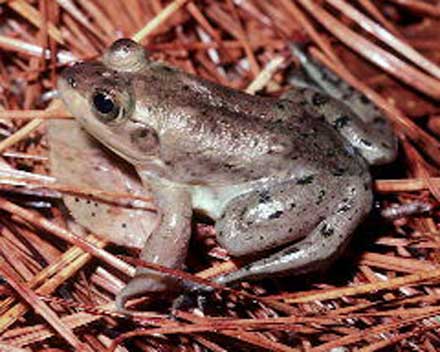
Lithobates grylio
Superregnum: Eukaryota
Cladus: Unikonta
Cladus: Opisthokonta
Cladus: Holozoa
Regnum: Animalia
Subregnum: Eumetazoa
Cladus: Bilateria
Cladus: Nephrozoa
Superphylum: Deuterostomia
Phylum: Chordata
Subphylum: Vertebrata
Infraphylum: Gnathostomata
Megaclassis: Osteichthyes
Cladus: Sarcopterygii
Cladus: Rhipidistia
Cladus: Tetrapodomorpha
Cladus: Eotetrapodiformes
Cladus: Elpistostegalia
Superclassis: Tetrapoda
Classis: Amphibia
Subclassis: Lissamphibia
Ordo: Anura
Familia: Ranidae
Genus: Lithobates
Species: Lithobates grylio
Name
Lithobates grylio Stejneger, 1901
Type locality: "Bay St. Louis, [Hancock County,] Mississippi", USA.
Holotype: USNM 27443.
Synonyms
Rana grylio Stejneger, 1901
Rana (Rana) grylio — Dubois, 1987
Rana (Aquarana) grylio — Dubois, 1992
Rana (Novirana, Aquarana) grylio — Hillis & Wilcox, 2005
Lithobates grylio — Frost et al. 2006
Lithobates (Aquarana) grylio — Dubois, 2006
Lithobates grylio — Crother
References
Crother, B.I. (2012). Scientific and standard English names of amphibians and reptiles of North America north of Mexico, with comments regarding confidence in our understanding. 7th ed. Society for the Study of Amphibians and Reptiles: Herpetological Circular no. 39. 92pp. PDF
Dubois, A. 1992. Notes sur la classification des Ranidae (Amphibiens anoures). Bulletin Mensuel de la Société Linnéenne de Lyon 61: 305–352. PDF
Frost, D.R., Grant, T., Faivovich, J., Bain, R.H., Haas, A., Haddad, C.F.B., de Sá, R.O., Channing, A., Wilkinson, M., Donnellan, S.C., Raxworthy, C.J., Campbell, J.A., Blotto, B.L., Moler, P., Drewes, R.C., Nussbaum, R.A., Lynch, J.D., Green, D.M., & Wheeler W.C. 2006. The Amphibian Tree OF Life. Bull. Am. Mus. Nat. Hist. Number 297, 370 pp., 71 figures, 5 tables, 7 appendices PDF
Hillis, D.M. & Wilcox, T.P. 2005. Phylogeny of the New World true frogs (Rana). Molecular Phylogenetics and Evolution 34(2): 299–314. DOI: 10.1016/j.ympev.2004.10.007 ResearchGate Reference page.
Hillis, D. M. (2007). Constraints in naming parts of the Tree of Life. Molecular Phylogenetics and Evolution 42: 331–338. PDF fulltext
Stejneger, 1901, Proc. U.S. Natl. Mus., 24: 212.
2007 IUCN Red List of Threatened Species IUCN: Lithobates grylio (Least Concern) Downloaded on 1 July 2008. (as Rana grylio)
Vernacular names
English: Pig Frog
The pig frog (Lithobates grylio[2]) is a species of aquatic frog found in the Southeastern United States, from South Carolina to Texas. Some sources also refer to it as the lagoon frog or the southern bullfrog.
Taxonomy
Norwegian-American naturalist Leonhard Stejneger described the pig frog in 1901, and it still bears its original name.
Description
The pig frog is green or grey-green in color, with brown or black blotching. It has fully webbed feet, a sharply pointed nose, and large tympana (eardrums). It is easily mistaken for various other species of the genus Lithobates, with which it shares its geographic range, including the American bullfrog (Lithobates catesbeiana). Pig frogs grow to a snout to vent length (SVL) of 85 to 140 millimetres (3+1⁄4 to 5+1⁄2 inches). They are known for their loud, deep snorting sound, reminiscent to the oinking sound of a pig.
Ecology and behavior
Almost entirely aquatic, they are found predominantly on the edges of lakes, or in cypress swamps and marshes that are heavy with vegetation. They are nocturnal. Their pig-like grunts can be heard during the warm months of the year.
Diet
Their primary diet is crayfish, but like most bullfrogs, they will consume almost anything they can swallow, including insects, fish, and other frogs.
Reproduction
Breeding takes place from spring through to summer. Eggs are laid in large masses of up to 10,000 at a time on the surface of the water. This species gets its common name from the call males use to attract females, which sounds somewhat like a pig's grunt.
Conservation status
The pig frog holds no particular conservation status and is relatively common in its range. The species has been introduced and established itself in China, Andros Island and New Providence Island in the Bahamas, as well as Puerto Rico.
Pig frogs have been reported to be raised for food by Chinese farmers, along with bullfrogs.[3]
Footnotes
Hammerson, G.A.; Hedges, B.; Joglar, R. (2008). "Lithobates grylio". IUCN Red List of Threatened Species. 2008: e.T58611A11810060. doi:10.2305/IUCN.UK.2008.RLTS.T58611A11810060.en. Retrieved 12 November 2021.
Frost, Darrel (2011). "American Museum of Natural History: Amphibian Species of the World 5.5, an Online Reference". Herpetology. The American Museum of Natural History. Retrieved 2013-02-17.
Court receives warning letter from local authorities in frog compensation case Archived 2016-04-14 at the Wayback Machine, based on June 2010 newspaper articles.
References
Frogs & Toads of Georgia: Pig Frog
Animal Diversity Web: Rana grylio
Amphibian Species of the World: Rana grylio
Hammerson, G.A.; Hedges, B.; Joglar, R. (2008). "Lithobates grylio". IUCN Red List of Threatened Species. 2008: e.T58611A11810060. doi:10.2305/IUCN.UK.2008.RLTS.T58611A11810060.en. Retrieved 12 November 2021. Database entry includes a range map and a brief justification of why this species is of least concern.
Hillis, D.M., & Wilcox, T.P. (2005). Phylogeny of the New World true frogs (Rana). Mol. Phylogenet. Evol. 34 (2): 299–314. doi:10.1016/j.ympev.2004.10.007 PDF fulltext.
Hillis, D.M. (2007). Constraints in naming parts of the Tree of Life. Mol. Phylogenet. Evol. 42: 331–338.
Stejneger L. 1901. A New Species of Bullfrog from Florida and the Gulf Coast. Proc. United States Nat. Mus. 24: 211-215. (Rana grylio, new species).
Retrieved from "http://en.wikipedia.org/"
All text is available under the terms of the GNU Free Documentation License

